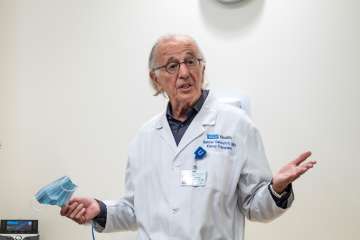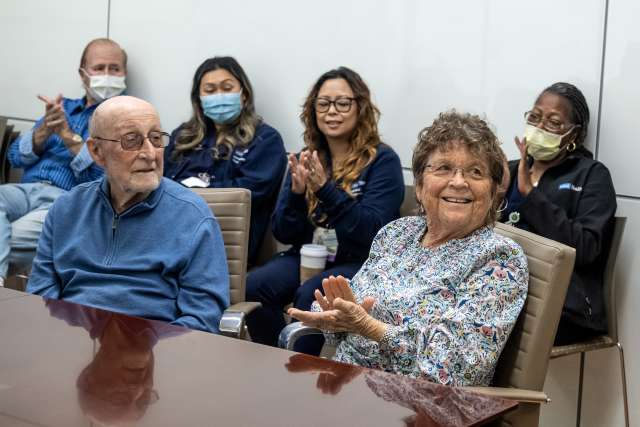In 1967, having already lost one daughter to a rare genetic disease, Ted Lombard, then age 39, donated one of his kidneys to her surviving twin, Denice. It was a risky option, given the high rates of organ rejection at the time, but it was 13-year-old Denice’s best hope for survival.
Fifty-six years later, his donated kidney is still going strong.
Ted, now 95, and Denice, 69, returned to UCLA, the site of that long-ago transplant, in late October to mark the occasion and raise awareness about the importance of organ donation.
A family’s persistence
Denice and her twin sister, Diane, were born in 1954 with a genetic disorder that eroded the function of their kidneys.
After Diane died at age 7, her grieving parents knew the options for Denice were limited. Even though Denice was the healthier of the two, it was only a matter of time before her kidneys would fail as well.
Organ donation was still uncommon, the first successful living donation having only occurred in 1954, the yearenice and Diane were born.
Nor was dialysis widely available; that wouldn’t occur until the 1970s, spurred in part by a 1972 decision by the U.S. Congress to cover dialysis for those with end-stage kidney disease. Moreover, as Denice’s mother, Anne, recounted in 2017, when she attempted to obtain dialysis for Denice back then she was told repeatedly that it was reserved for male heads of households.
While Anne pushed to get Denice on experimental drugs and fought with insurance companies to get them to agree to cover the costs for a transplant, Ted underwent testing to determine if it would be safe for him to donate a kidney and whether the kidney would be a good match for Denice.
The family also had to find a hospital willing to do the procedure, given that success was far from certain.
“Back then, the chances of success were maybe 50/50,” said Gabriel Danovitch, MD, emeritus medical director of the UCLA Health Kidney Transplant Program. “Now, they’re more like 95 percent.”
By this point it was 1967, and 13-year-old Denice’s kidneys had already started to fail. “I had no energy,” Denice recalled. “It was exhausting to try to lift the brush and brush my hair.”
The doctors at UCLA agreed to do the procedure, and Dr. Robert Smith performed the transplant. “I was not a transplant surgeon per se,” recalled Dr. Smith, who retired from UCLA in 2019 but was on hand last month to meet with Denice and Ted Lombard. “This was in the days when transplantation was early, and I was a urologist who also got assigned to do renal transplants.”
For Denice’s father, the procedure was an open surgery, given that minimally invasive laparoscopic surgery to remove kidneys wouldn’t become common for several decades.
“The operation was a much bigger and more painful operation than it is now,” Dr. Danovitch said. “The whole concept of living donor transplantation was new and success rates were much lower than they are now. He was taking risks, both for himself and for his daughter.”

Although Denice was 13 at the time of the surgery, she was quite small, given her health issues. That made the transplant more difficult, Dr. Smith recalled. Both of her kidneys were removed, and the new kidney was placed in her abdominal cavity.
Denice stayed in the hospital for about two weeks after the procedure, but her new kidney started working right away. “It started producing urine within about 30 minutes,” she said. “I remember there were gallon jugs of my urine on the windowsill in the room I was in, and everybody was so thrilled.”
She initially suffered transplant rejection, but Denice's care team was able to address it quickly, she said. Her skin, which had been grayish, quickly became a healthy pink, and her energy returned.
Longer term, though, the biggest risk was that her immune system would reject the transplanted organ. Denice was prescribed high doses of prednisone, a steroid to help prevent this, which left her with a “moon face,” she recalled. “I was physically out of the woods, but I suffered emotionally because I was very short and had a big round face.”
In addition to the prednisone, which Denice still takes at a low dose to this day, she was put on azathioprine, one of the earliest immunosuppressive medications.
That likely proved to be a key factor in the longevity of her donated kidney.
“While newer immunosuppressive medications are generally better at preventing rejection, they can impair kidney function over the long term,” Dr Danovitch explained. In Denice’s case, her father’s donated kidney was “by definition, a half match. Any time you get a transplant from a close relative, there is an advantage.”
The risk of rejection was therefore lower, which meant that the increased immunosuppressive ability of newer medications ended up being less critical for her. Meanwhile, because the older medication is gentler long-term on kidney function, “this may be one of the reasons why the kidney has functioned for so long,” Dr. Danovitch said.
Still, the longevity of her donated kidney is “an outlier,” he said. “I think it may be a combination of things: it came from a young father, she was young when she got it, and over the years she’s had blood pressure that’s been well controlled. And she was not exposed to the drugs that could potentially have impaired her kidney function.”
Not enough kidneys
While the newer anti-rejection medications have greatly improved outcomes and made transplants from a broader pool of donors (including deceased donors) possible, there are still far more people who need kidneys than there are available organs.
Nearly 89,000 patients were on the national waitlist to receive a kidney as of November 2023, according to the U.S. Department of Health and Human Services Organ Procurement and Transplantation Network database.
And even though the number of kidney transplants is up by about 7.5% year to date (on track to exceed the record 21,477 kidney transplants in 2022), it’s not nearly enough to meet the need.
The monthly numbers vividly illustrate this: In October, an average of 152 people a day were added to the national kidney transplant wait list, but only an average of 78 kidney transplants a day were performed, according to the United Network for Organ Sharing. As a result, the average wait time to receive a kidney can be five to 10 years.
Meanwhile, living donor transplants such as Denice’s still only account for about 30% of all kidney transplants, even though the odds of long-term success are better if patients receive an organ from a living donor rather than a deceased one.
As Denice’s mom pointed out in 2017, on the 50th anniversary of Denice’s transplant surgery, “If you want to save a life, you donate a live kidney.”
Living donor organs are less likely to be rejected by the patient’s immune system and are generally healthier and last longer than organs from deceased donors. Living kidney donors undergo an intensive evaluation of all aspects of their health to ensure that the procedure is safe for them, both in the short and long term.
Potential donors who are not a direct match for the patient are encouraged to participate in the living donor exchange program so they can provide a kidney to a compatible patient. The resulting “kidney chain” provides the donor’s kidney to someone else in need, and the initial patient can receive a kidney from a different but compatible donor. UCLA Health can coordinate kidney swaps for multiple pairs of donors and recipients.
Encouraging organ donation
Denice hopes that her story will help raise awareness and encourage more people to get screened as kidney donors. Despite donating a kidney all those years ago, her father has “lived a full life,” she said. “He skied and kayaked and played tennis, and he made furniture and traveled. It didn't affect him at all.”
Denice, too, has led a full life, thanks to her father’s donation. “I was very physically active and very politically active,” she said. “I wasn’t focused on my kidney transplant; I just lived my life and wasn’t worried about the future. And I’m still healthier than any of my friends.”
Although the function of her kidney, which is now 95 years old, has started to slow down, “I think it still has considerable life in it,” Dr. Danovitch said, adding that it’s likely to last her through her lifespan.
“She’s a remarkable woman,” he added. “She radiates optimism.”
Over the years, Denice has spoken publicly about the need for organ donation.
She’s also made plans that she hopes will advance awareness even further: donating her body to science once she dies. Her body will go to medical students at UCLA Health, she said, where it will be used for medical education and research. “I really want it to be connected to research of kidney transplants,” she noted, “but I haven’t figured out how to make that happen.”
She assumes the students and researchers will see her 11-inch scar, which stretches from her breastbone down to her pubic bone. But she also has a plan, in case they aren’t aware of her 1967 kidney transplant.
“I don’t think they get the medical records,” she said. “So I’m going to have my sister write with a Sharpie on my abdomen, ‘Kidney in here’ and the transplant date, so they’re aware of it.”
Lisa L. Lewis is the author of this article.



